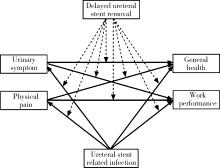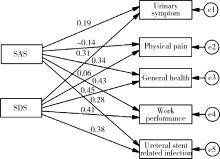Journal of Peking University (Health Sciences) ›› 2023, Vol. 55 ›› Issue (5): 857-864. doi: 10.19723/j.issn.1671-167X.2023.05.013
Previous Articles Next Articles
Effects of delayed ureteral stents removal during the COVID-19 pandemic on the quality of life and psychological status of postoperative patients with urinary calculi
Jin-hui LAI,Qi WANG,Jia-xiang JI,Ming-rui WANG,Xin-wei TANG,Ke-xin XU,Tao XU,Hao HU*( )
)
- Department of Urology, Peking University People's Hospital, Beijing 100044, China
CLC Number:
- R699
| 1 |
Alnadhari I , Alwan MA , Salah MA , et al. Treatment of retained encrusted ureteral double-J stent[J]. Arch Ital Urol Androl, 2019, 90 (4): 265- 269.
doi: 10.4081/aiua.2018.4.265 |
| 2 |
Tae BS , Cho S , Jeon BJ , et al. Does mirabegron relieve ureteric stent-related discomfort? A prospective, randomized, multicentre study[J]. BJU Int, 2018, 122 (5): 866- 872.
doi: 10.1111/bju.14416 |
| 3 |
Bosio A , Alessandria E , Dalmasso E , et al. How bothersome double-J ureteral stents are after semirigid and flexible ureteroscopy: A prospective single-institution observational study[J]. World J Urol, 2019, 37 (1): 201- 207.
doi: 10.1007/s00345-018-2376-6 |
| 4 |
Lin TF , Lin WR , Chen M , et al. The risk factors and complications of forgotten double-J stents: A single-center experience[J]. J Chin Med Assoc, 2019, 82 (10): 767- 771.
doi: 10.1097/JCMA.0000000000000161 |
| 5 |
Rabani SM . Combined percutaneous and transurethral lithotripsy for forgotten ureteral stents with giant encrustation[J]. Nephrourol Mon, 2012, 4 (4): 633- 635.
doi: 10.5812/numonthly.4087 |
| 6 |
Nerli RB , Magdum PV , Sharma V , et al. Forgotten/retained double J ureteric stents: A source of severe morbidity in children[J]. Afr J Paediatr Surg, 2016, 13 (1): 32- 35.
doi: 10.4103/0189-6725.181704 |
| 7 |
Westhofen T , Magistro G , Lennartz S , et al. Confronting hidden COVID-19 burden: A telemedical solution for elective urological outpatient clinics[J]. Infection, 2020, 48 (6): 935- 939.
doi: 10.1007/s15010-020-01511-7 |
| 8 |
Zhu C , Qu J , Yang L , et al. The chinese linguistic validation of the ureteral stent symptom questionnaire[J]. Urol Int, 2019, 102 (2): 194- 198.
doi: 10.1159/000493764 |
| 9 |
Wang C , Zhao H . The Impact of COVID-19 on anxiety in Chinese university students[J]. Front Psychol, 2020, 11, 1168.
doi: 10.3389/fpsyg.2020.01168 |
| 10 | Lei L , Huang X , Zhang S , et al. Comparison of prevalence and associated factors of anxiety and depression among people affected by versus people unaffected by quarantine during the COVID-19 epidemic in southwestern China[J]. Med Sci Monit, 2020, 26, e924609-1- e924609-12. |
| 11 |
Wu G , Sun F , Sun K , et al. Impact of differential ureteral stent diameters on clinical outcomes after ureteroscopy intracorporeal lithotripsy: A systematic review and meta-analysis[J]. Int J Urol, 2021, 28 (10): 992- 999.
doi: 10.1111/iju.14631 |
| 12 |
Pecoraro A , Peretti D , Tian Z , et al. Treatment of ureteral stent-related symptoms[J]. Urol Int, 2023, 107 (3): 288- 303.
doi: 10.1159/000518387 |
| 13 |
Bao X , Sun F , Yao H , et al. Distal end of double-J ureteral stent position on ureteral stent-related symptoms: A systematic review and meta-analysis[J]. Front Surg, 2022, 9, 990049.
doi: 10.3389/fsurg.2022.990049 |
| 14 |
Kuehhas FE , Miernik A , Sharma V , et al. A prospective evaluation of pain associated with stone passage, stents, and stent removal using a visual analog scale[J]. Urology, 2013, 82 (3): 521- 525.
doi: 10.1016/j.urology.2013.04.031 |
| 15 | Polat H , Yucel MO , Utangac MM , et al. Management of forgotten ureteral stents: Relationship between indwelling time and required treatment approaches[J]. Balkan Med J, 2017, 34 (4): 301- 307. |
| 16 |
Bidnur S , Huynh M , Hoag N , et al. An indwelling ureteral stent forgotten for over 12 years[J]. J Endourol Case Rep, 2016, 2 (1): 135- 137.
doi: 10.1089/cren.2016.0073 |
| 17 |
Nevo A , Mano R , Baniel J , et al. Ureteric stent dwelling time: A risk factor for post-ureteroscopy sepsis[J]. BJU Int, 2017, 120 (1): 117- 122.
doi: 10.1111/bju.13796 |
| 18 | Ramachandra M , Mosayyebi A , Carugo D , et al. Strategies to improve patient outcomes and QoL: Current complications of the design and placements of ureteric stents[J]. Res Rep Urol, 2020, 12, 303- 314. |
| 19 | Kartal IG , Baylan B , Gok A , et al. The association of encrustation and ureteral stent indwelling time in urolithiasis and KUB grading system[J]. Urol J, 2018, 15 (6): 323- 328. |
| 20 |
Frank A , Hormann S , Krombach J , et al. COVID-19 concerns and worries in patients with mental illness[J]. Psychiatr Prax, 2020, 47 (5): 267- 272.
doi: 10.1055/a-1179-4230 |
| 21 |
Wang Y , Yang Y , Yan C , et al. COVID-induced 3 weeks' treatment delay may exacerbate breast cancer patient's psychological symptoms[J]. Front Psychol, 2022, 13, 1003016.
doi: 10.3389/fpsyg.2022.1003016 |
| [1] | Min WANG, Qian LI. Path analysis of influencing factors of mental resilience in adolescents with depression [J]. Journal of Peking University (Health Sciences), 2024, 56(5): 809-814. |
| [2] | Huameng TANG,Dianqi YUAN,Mingxing WANG,Hanbing YANG,Chao GUO. Sequential mediating role of digital participation and health lifestyle in the relationship between socioeconomic status and depression of older adults [J]. Journal of Peking University (Health Sciences), 2024, 56(2): 230-238. |
| [3] | Wen YUAN,Yi ZHANG,Li CHEN,Jia-nuo JIANG,Man-man CHEN,Jie-yu LIU,Tao MA,Qi MA,Meng-jie CUI,Tong-jun GUO,Xin-xin WANG,Yan-hui DONG,Jun MA. Association of body fat distribution with depression and social anxiety in children and adolescents: A cross-sectional study based on dual-energy X-ray detection [J]. Journal of Peking University (Health Sciences), 2023, 55(3): 429-435. |
| [4] | Yi-hua LIU,Qing-ping YUN,Lan-chao ZHANG,Xiao-yue ZHANG,Yu-ting LIN,Fang-jing LIU,Zhi-jie ZHENG,Chun CHANG. Joint association of sedentary behavior and physical activity on anxiety tendency among occupational population in China [J]. Journal of Peking University (Health Sciences), 2022, 54(3): 490-497. |
| [5] | FAN Li-shi,GAO Min,Edwin B. FISHER,SUN Xin-ying. Factors associated with quality of life in 747 patients with type 2 diabetes in Tongzhou District and Shunyi District of Beijing [J]. Journal of Peking University (Health Sciences), 2021, 53(3): 523-529. |
| [6] | Yi-fan WANG,Zhen FAN,Yao-bin CHENG,Yue-bo JIN,Yang HUO,Jing HE. Investigation of sleep disturbance and related factors in patients with primary Sjögren’s syndrome [J]. Journal of Peking University (Health Sciences), 2020, 52(6): 1063-1068. |
| [7] | Yan GENG,Zhi-bo SONG,Xiao-hui ZHANG,Xue-rong DENG,Yu WANG,Zhuo-li ZHANG. Depression and anxiety in patients with psoriatic arthritis: Prevalence and associated factors [J]. Journal of Peking University (Health Sciences), 2020, 52(6): 1048-1055. |
| [8] | Duan YI,Wei ZHU,Xiu-li MENG,Xiao-guang LIU,Shui-qing LI,Bin ZHU,Dong-lin JIA. Analysis of anxiety, depression and related factors in patients with chronic lumbocrural pain before minimally invasive surgery [J]. Journal of Peking University (Health Sciences), 2020, 52(2): 285-289. |
| [9] | WANG Tian-jiao, LIU Yu, GUAN Ming. Intravenous sedation with midazolam and propofol target controlled infusion on patients’ perioperative anxiety under the mandibular third molar extraction [J]. Journal of Peking University(Health Sciences), 2017, 49(6): 1044-1049. |
| [10] | LEI Jie,LIU Mu-qing,FU Kai-yuan. Disturbedsleep, anxiety and stress are possible risk indicators for temporomandibular disorders with myofascialpain [J]. Journal of Peking University(Health Sciences), 2016, 48(4): 692-696. |
| [11] | LIU Yi-Xuan, ZHANG Yong-Shen, DUAN Li-Ping, ZHANG Lu, YANG Chang-Qing. Effect of inherent depression on chronic visceral hypersensitivity induced by colon acetate stimulation in neonatal rats [J]. Journal of Peking University(Health Sciences), 2015, 47(2): 289-294. |
| [12] | ZHANG Hong-Mei, XIA Bin, WANG Jian-Hong, CHEN Xiao-Xian, GE Li-Hong. Influence of the effect of general anaesthesia and restraint during dental treatment on dental anxiety and behavior in children [J]. Journal of Peking University(Health Sciences), 2015, 47(1): 134-139. |
|
||



